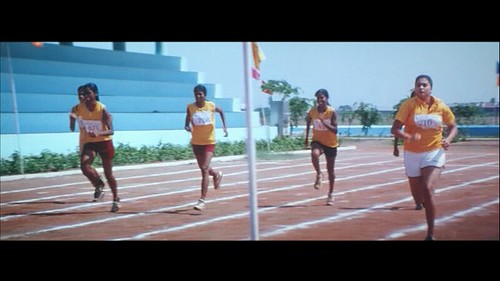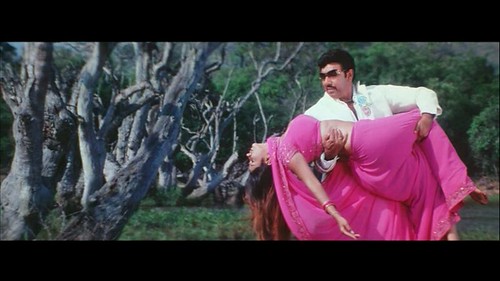
As the year draws to a close, it is time to unveil another gem from Englishkaran. The hour is ripe to introduce the heroine of the film's second half. Namitha's the name of Lady Lipids. She put a bikini to shame in Billa and returns in this film to challenge the limits of human acceptance of size, proportion and taste. Jiggles has a burning desire to win prizes in running. That little detail alone justifies that familiar disclaimer about stuff like this being works of fiction (no stretch is too much). We are treated to enough footage of her running and –- wait for it -- winning!!  Since she appears in a flashback that is crucial to tie up the loose ends about Sathyaraj's character (whom the title refers to, puTTan), it is not surprising that we have a romantic song and dance sequence featuring the two prancing about in domestic jungle-like setups (pages torn out of books like Rangeela). Given the rather obviously significant difference in size, it would make sense for Namitha to do the lifting and posing. However, convention requires the man to be the lifter, poser and support system for the female form. Consequently, we are treated to visuals of Sathyaraj doing his own stunts (supporting Namitha in various romantic poses) and of Namitha mooning the camera and challenging the widescreen format (on paper this must have been designed as a booty teaser for the lascivious laddies sitting in the dress circle). All this is accompanied by a song whose lyrics employ metaphors from war (the boy is compared to Mohammad Gazni -- who gave his name to two commercial potboilers exploiting anterograde amnesia; the girl and her assets are compared to bastions of defence). It's a strange howlarious mix that could cause you to choke on your lunch.
Since she appears in a flashback that is crucial to tie up the loose ends about Sathyaraj's character (whom the title refers to, puTTan), it is not surprising that we have a romantic song and dance sequence featuring the two prancing about in domestic jungle-like setups (pages torn out of books like Rangeela). Given the rather obviously significant difference in size, it would make sense for Namitha to do the lifting and posing. However, convention requires the man to be the lifter, poser and support system for the female form. Consequently, we are treated to visuals of Sathyaraj doing his own stunts (supporting Namitha in various romantic poses) and of Namitha mooning the camera and challenging the widescreen format (on paper this must have been designed as a booty teaser for the lascivious laddies sitting in the dress circle). All this is accompanied by a song whose lyrics employ metaphors from war (the boy is compared to Mohammad Gazni -- who gave his name to two commercial potboilers exploiting anterograde amnesia; the girl and her assets are compared to bastions of defence). It's a strange howlarious mix that could cause you to choke on your lunch.

Without much ado, oglers and gigglers, I present the transcript of the subtitles for this fascinating romantic romp
wage a war!
wage a war against the
eighteen year old fortress
overcoming all ups and downs
and passing over forests and hills
venture into the capital city, win over
the head lady and hoist the flag
let the ten fingers ignite
let the flowers bloom in this cannon
oh kattabomman!
come to pay the taxes
come to pay taxes with interest
there is still more
break the bones
make this volcano turn
into a 'cherapunji hill'
would vegetarian suffice for a lion?
can river cauvery be contained in a pot?
use the sari as the mast
to cross the 'river of lust'
you looted me without my knowledge
oh dear! take me to
the place never gone before
i would be with you like
a bow with an arrow
would whitewash the
never dawning night
suffocate me with kisses
why are you so stingy with desires?
oh gajini mohammad!
wage a war!
wage a war against the
eighteen year old fortress
in the beauty of...
cavalry would lose
seeing the footprints
the infantry would lose
at my wink, elephant troops
would become cat troops
soldiers would lose
at your smile
navy would lose
at seeing your navel
not an army but the eye arrows
are enough to defeat you
wind me with your eye keys
and satisfy me, oh dear!
issue an order with your hands and ignite
my dreams with the flowers in your tress
flowers are there, tress is there
snap and ask whatever you want
oh gajini mohammad!
wage a war!
wage a war against the
eighteen year old fortress
overcoming all ups and downs
and passing over forests and hills
venture into the capital city, win over
the head lady and hoist the flag
let the ten fingers ignite
let the flowers bloom in this cannon
let the ten fingers ignite
let the flowers bloom in this cannon



